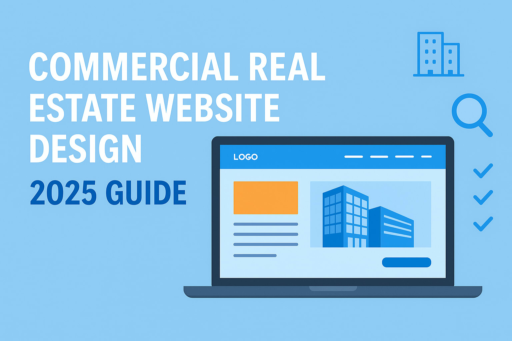In the increasingly competitive world of commercial real estate (CRE), a well-designed website is not merely an online presence—it’s a critical business tool. Your website serves as the first point of contact for prospective clients, tenants, and investors, and plays a significant role in converting leads into business opportunities. With the rapid advancements in technology and changes in user behavior, creating a website that meets both user expectations and industry standards is crucial.
In this comprehensive guide, we’ll explore the key components that define a successful commercial real estate website, emerging trends in web design, and essential tips for working with web developers to ensure your site stands out in 2025.
Why Commercial Real Estate Website Design Matters
The importance of an optimized website for commercial real estate cannot be overstated. According to a recent study, 94% of first impressions of a website are design-related, which means the visual appeal, usability, and performance of your site will directly impact your reputation and business. In a sector where competition is fierce, having a website that is easy to navigate, aesthetically pleasing, and informative can give you a decisive edge.
Your website is more than a digital brochure; it’s a dynamic, interactive tool that helps potential clients find properties, schedule viewings, and gain trust in your expertise. A poorly designed site can harm your reputation and drive potential leads to competitors. With the stakes this high, creating a website that performs well both in terms of functionality and design is paramount.
Key Features Every Commercial Real Estate Website Must Have
1. Clean, Professional, and User-Centered Design
The first element visitors will notice on your website is its design. In commercial real estate, where trust and professionalism are key, the design of your website plays a significant role in establishing credibility. A clean, professional design gives visitors confidence in your business and helps them navigate your site efficiently.
Design Best Practices:
- Minimalism: Opt for a minimalist design with a limited color palette and well-organized layout. This reduces visual clutter and directs attention to your listings and calls to action (CTAs).
- Branding Consistency: Ensure that your website reflects your brand identity through consistent use of colors, typography, and imagery that aligns with your company’s values.
- Responsive Design: A mobile-friendly site is no longer optional—it’s a necessity. With mobile traffic surpassing desktop traffic, ensure your website is optimized for smartphones and tablets, providing a seamless experience across all devices.
2. Advanced Property Search Functionality
Commercial real estate clients typically have specific requirements when searching for properties. Your website’s search function should allow them to filter listings based on various criteria, such as location, price, size, amenities, and more.
Recommended Features:
- Map Search Functionality: Allow clients to visualize properties on a map, helping them better understand the property’s location and surrounding area.
- Advanced Filters: Enable clients to narrow down their search by property type, price range, lease duration, and specific features like parking, accessibility, and amenities.
- Save and Compare Options: Provide the ability for users to save their favorite properties and compare them side by side, offering them a more interactive, personalized experience.
3. Integration of 3D Virtual Tours and Interactive Tools
The use of 3D virtual tours and other interactive tools has revolutionized the way people browse commercial properties online. These tools provide an immersive, realistic experience of the space, allowing users to explore properties remotely and get a feel for the layout and design.
Why Virtual Tours Matter:
- Improved Engagement: Interactive tours keep visitors engaged for longer periods, which can reduce bounce rates and encourage further interaction with the website.
- Time Efficiency: Virtual tours save time for both clients and real estate professionals by allowing prospective buyers or tenants to explore the property before arranging an in-person visit.
- Accessibility: Virtual tours are particularly useful for international or out-of-town clients who may not be able to physically visit the property in person.
4. Strong SEO Foundation for Increased Visibility
Search engine optimization (SEO) is essential for ensuring your website ranks high on search engine results pages (SERPs). By optimizing your content and structure, you can improve your visibility and drive more organic traffic to your site.
SEO Best Practices:
- Keyword Strategy: Integrate relevant keywords such as “commercial real estate website design,” “property developer websites,” and “best commercial real estate web design” into your content, page titles, and meta descriptions.
- Local SEO Optimization: Include location-specific keywords to ensure your site ranks for regionally relevant searches (e.g., “commercial real estate website design in New York”).
- Technical SEO: Ensure your website is technically optimized with fast loading speeds, clean URLs, and optimized images. Google rewards sites that provide a seamless user experience.
5. Compelling Content to Drive Engagement and Trust
Content is a crucial element in attracting, engaging, and converting website visitors. In addition to showcasing property listings, your website should offer valuable resources such as market insights, case studies, blog posts, and property management tips.
Content Ideas to Include:
- Industry Insights and Trends: Provide regular updates on market trends, investment opportunities, and commercial property news to demonstrate your expertise.
- Case Studies and Client Testimonials: Highlight successful projects, satisfied clients, and the positive impact your services have had. Real-world examples build credibility and trust.
- Educational Resources: Share guides, tips, and resources that help potential clients make informed decisions, such as “How to Choose the Right Commercial Property” or “The Benefits of Leasing Commercial Real Estate.”
6. Fast Loading Speed for Optimal User Experience
Website performance is critical. If your website takes too long to load, you risk losing potential clients. In fact, studies have shown that 53% of mobile users abandon websites that take longer than three seconds to load. Speed is a direct factor in both user experience and SEO rankings.
Performance Optimization Tips:
- Image Optimization: Compress images to reduce their file size while maintaining quality, ensuring fast loading without sacrificing visual appeal.
- Caching and Lazy Loading: Implement caching to reduce load times on repeat visits, and use lazy loading for images to improve initial page load speed.
- Minimize External Scripts: Limit the number of external scripts and resources to decrease the number of HTTP requests.
Emerging Trends in Commercial Real Estate Website Design
1. AI Integration for Personalized Experiences
Artificial intelligence (AI) is enhancing user experiences by delivering personalized content and automating processes. AI-powered chatbots can answer questions in real-time, recommend properties based on user behavior, and even schedule viewings.
2. Augmented Reality (AR) for Virtual Property Tours
AR technology allows users to interact with commercial properties in ways that were previously not possible. Prospective clients can visualize changes or upgrades to a property, such as renovations or layout changes, providing a more accurate representation of the space.
3. Voice Search Optimization
As smart speakers and voice assistants become more prevalent, optimizing your website for voice search is becoming crucial. Commercial real estate websites can optimize content for natural language queries, allowing users to find properties via voice commands like, “Show me commercial office spaces near downtown.”
How to Choose the Right Commercial Real Estate Website Developer
Selecting the right developer is vital to ensuring your website performs at the highest level. Here’s what you should look for when hiring a web developer for your commercial real estate site:
- Experience in Real Estate: Choose a developer with a proven track record in designing and developing commercial real estate websites.
- Custom Development: Ensure the developer can provide tailored solutions to meet your unique business needs, from advanced search features to custom design elements.
- Ongoing Support and Maintenance: The web development process doesn’t end with the launch. Opt for a developer who offers long-term support and can help with future updates and improvements.
Conclusion
Designing a commercial real estate website that meets the expectations of today’s clients requires careful planning, attention to detail, and an understanding of the latest industry trends. By incorporating advanced search features, virtual tours, engaging content, and optimized performance, you can ensure your website stands out in the competitive real estate market of 2025.
A well-designed website doesn’t just attract visitors—it converts them into leads, tenants, and long-term clients. If you’re looking to elevate your commercial real estate website, partner with a professional web developer who understands the unique needs of your industry and can deliver a solution that drives results.






